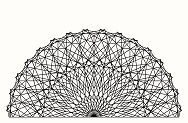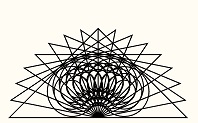


 |
 |
 |
Greenhouse operators add three to five times as much carbon dioxide to the air to improve plant growth. Carbon Dioxide In The Atmosphere
Volcanoes added back carbon dioxide during the dinosaur years; but the volcanoes died down due to tectonic plates getting thicker over time. So now volcanoes cannot add carbon dioxide to the atmosphere as fast as oceans remove it. This CO2 graph is one of the most monumental facts of science. It tells the story of geology, biology and evolution over the span of terrestrial life showing the timing of events and quantitative significance of many events. A good starting point for this subject is to understand that the earth's crust (and top mantle layer) continually gets thicker as the planet cools. It's not clear what happened during the first billion years on earth, but by the time terrestrial life began, about 500 million years ago (mya), the patterns were clearly established.
As terrestrial life began, about 500 mya, the land mass consisted of a supercontinent called Gondwana. It reformed into Pangaea about 335 mya. Supercontinents formed as a result of tectonic plates sticking together as they bumped into each other. Tectonic plates no longer do that, because they are so thick now that they slide over and under each other as they move around. As the plates slide over and under each other, two major events occur. One is that mountains substantially increase due to buckling of the crust. The other is that volcanoes form where the plates overlap. The increase in carbon dioxide in the atmosphere as Pangaea formed would have been due to volcanoes. The buckling of the plates caused volcanoes to occur.
The reason why the lowlands would have been covered with the nonwoody brush which dinosaurs ate is because that type of vegetation saturates its environment. Nothing but mountains would have been limiting the growth of the nonwoody brush until grass formed around the transition when dinosaurs died out. The CO2 graph shows an almost complete disappearance of CO2 in the atmosphere about when conifers began to evolve 300 mya. The needly leaves of conifers would have been a result of a shortage of CO2, which required maximum surface area for absorption. Only later did broad leaf trees form, and then light would have been the shaping influence, as CO2 was abundant. The reason why CO2 almost disappeared from the atmosphere 315 mya is because oceans continually absorb CO2 and tie it up as calcium carbonate and limestone. Calcium in the oceans attracts CO2, as do all alkalis, since CO2 is an acid. The oceans never run out of calcium, as it keeps entering through the rivers and gets recycled as land masses move out of the oceans over time. Calcium carbonate is a buffer in the oceans which holds the pH at 8.1, which is significantly alkaline. There is no reason to assume the oceans have ever been any other pH in the history of terrestrial life contrary to endless fake claims of guessing at different pHs and sometimes calling it science. The amount of CO2 in the atmosphere began to increase just as the mountains were forming 300 mya and for the same reason. The tectonic plates were getting so thick that they began to move over and under each other as they pushed against each other. This effect causes volcanoes to increase, which adds CO2 to the atmosphere. The reason why the CO2 level dropped back down in recent times is because volcanic activity decreased, as the tectonic plates got so thick that magma could not easily get to the surface. All the time, the oceans keep absorbing CO2 from the atmosphere due to the perpetual presence of calcium. The large size of dinosaurs would have been caused by the nonwoody brush that they had to walk through and used for food. Walking through brush takes a lot of power. As a result, the size of dinosaurs increased as the nonwoody brush got more dense. Dinosaurs could not eat the conifers which evolved on the slopes of mountains. There would have been evolutionary pressure causing conifers to resist being eaten by dinosaurs. The highly inedible chemistry that conifers acquired would have been largely a response to dinosaurs trying to eat them. The conifers would have left some space around them for complex evolution which included grass, flowering plants and the puffball and bolete mushrooms. But there was so little space for these diverse species that there numbers were miniscule and almost invisible in the fossil record. It was grass that reshaped biology around flowering plants, broadleaf trees and the diversity of mammals. Grass prevented the nonwoody brush from getting reestablished, while flowering plants and mammals thrived with the grass. Notice how low the carbon dioxide level was at the extinction. The shortage of CO2 made grass leaves narrow, just as it created needly leaves for conifers. Maximum surface area was needed for absorbing the scarce CO2. Grass was gradually taking over the nonwoody brush before the extinction event as indicated by Anzu wyliei, which was one of the last dinosaurs to evolve. It had long legs and looked like a large chicken. The long legs would have evolved from the need to walk through grass. It means grass was becoming significantly established by the time the extinction event occurred. Notes The evidence of nonwoody brush overwhelming biology and holding back evolution is in the size of dinosaurs and restricted evolution. It takes environmental influences to create evolutionary change. The dinosaurs had to be large to walk through brush. Then there is the agricultural experience along with tromping through old-growth forests in Oregon, which shows the nature of nonwoody plants and brush. Low-level growth and brush gets thick and hard to walk through. Competition takes up ground space and creates vertical growth. P. fluorescens And Mitochondria
|
|
|||||||||||||||||
 | |
 |
 |
 | ||
 |
 |
 |
||